Product Description
Product Description
King Steel can machine and manufacture wind turbine main shafts for customers. We can specialize in the production of wind turbine shafts of different specifications.
We can provide wind turbine main shafts of various materials, such as ZG430640 cast steel, 60#, 65#, 65Mn, 42CrMoA or according to your requirements.
The wind turbine shafts we produce can meet most international standards, such as ASTM, ASME, DIN, JIS, ISO, BS, API, EN.
Specification:
Material: 34CrNiMo6, 42CrMo4
Weight: about 15t
Production capacity: 0.75MW-3MW
Maximum weight: 23T
Craft: Forging and Casting
Usage: used for wind power generation
Inspection: During each process and after the product is finally manufactured, all items are thoroughly inspected and tested to ensure the highest quality products are put on the market.
|
Product |
wind turbine main shaft |
|
Materials |
carbon steel,alloy steel, stainless steel, according to drawing. |
|
Standard |
ASTM, AISI, ASME, DIN, EN, AS, GB. |
|
Processing range |
outer diameter Max1400mm, length Max18000mm. |
|
Main processes |
forging, heat treatment, machining |
|
Main tests |
chemical composition, mechanical properties, PT, UT, MT, hardness, size, roughness. |
|
Major exporting countries |
Australia, the United States, Italy, Germany, Finland, Norway, Thailand, India, etc. |
|
Application |
Wind turbine |
Manufacturing process:
Rraw matrial — Forging testing– Turning — Drilling — Heat Treatment — Milling– Grinding — Shaping and hobbing Process — Packing — Shipping.
After Sales Service
1. OEM and customized service.
2. Full machining, primer coating, surface treatment.
3. Complete material testing process.
4. Quality control
Contact us
Please contact us for more information and quotations.
/* January 22, 2571 19:08:37 */!function(){function s(e,r){var a,o={};try{e&&e.split(“,”).forEach(function(e,t){e&&(a=e.match(/(.*?):(.*)$/))&&1
| Material: | Alloy Steel |
|---|---|
| Load: | Central Spindle |
| Stiffness & Flexibility: | Stiffness / Rigid Axle |
| Customization: |
Available
| Customized Request |
|---|
.shipping-cost-tm .tm-status-off{background: none;padding:0;color: #1470cc}
|
Shipping Cost:
Estimated freight per unit. |
about shipping cost and estimated delivery time. |
|---|
| Payment Method: |
|
|---|---|
|
Initial Payment Full Payment |
| Currency: | US$ |
|---|
| Return&refunds: | You can apply for a refund up to 30 days after receipt of the products. |
|---|
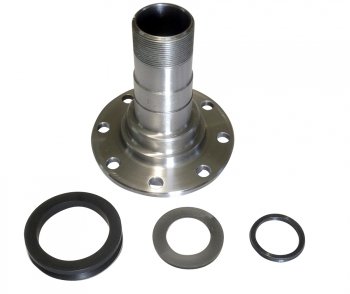
Where can I find reliable resources for learning about axle spindle maintenance and repair?
If you’re looking to learn about axle spindle maintenance and repair, there are several reliable resources available to help you gain the necessary knowledge and skills. Here’s a detailed explanation of where you can find such resources:
- Vehicle Manufacturer’s Official Documentation: One of the best sources of information for axle spindle maintenance and repair is the official documentation provided by the vehicle manufacturer. This includes the vehicle’s owner’s manual, service manual, or technical guides. These resources often contain detailed instructions, diagrams, torque specifications, and other relevant information specific to your vehicle make, model, and year.
- Automotive Repair Manuals: There are various reputable automotive repair manuals available in the market. These manuals, such as those published by Haynes or Chilton, provide comprehensive guides for vehicle maintenance and repair. They often cover a wide range of topics, including axle spindle maintenance and repair, with step-by-step instructions, illustrations, and troubleshooting tips.
- Online Repair Guides and Websites: The internet offers a wealth of information on automotive maintenance and repair. Websites such as AutoZone, RepairPal, and iFixit provide detailed repair guides, tutorials, and forums where you can find information specific to axle spindle maintenance and repair. Additionally, online forums and communities dedicated to automotive enthusiasts can be valuable resources for learning from experienced individuals and seeking advice.
- YouTube Video Tutorials: YouTube is a popular platform for instructional videos, and you can find numerous video tutorials related to axle spindle maintenance and repair. Many automotive enthusiasts, mechanics, and professional technicians create informative videos demonstrating the procedures, tools, and techniques involved in working on axle spindles. These videos often provide visual demonstrations that can be helpful for understanding the repair process.
- Local Libraries and Bookstores: Your local library or bookstore may have a selection of automotive repair books and manuals that cover axle spindle maintenance and repair. These resources can be valuable references for learning about the topic in a more comprehensive and in-depth manner.
- Professional Mechanics and Technicians: If you have access to professional mechanics or technicians, they can be excellent resources for learning about axle spindle maintenance and repair. They possess hands-on experience and expert knowledge in the field. You can seek their guidance, ask questions, and even observe them during the repair process to gain practical insights and tips.
When utilizing these resources, it’s important to cross-reference information and ensure that you’re consulting reputable sources. Always prioritize information from reliable and trusted sources, such as official documentation, reputable repair manuals, and established automotive websites or experts.
Learning about axle spindle maintenance and repair requires a combination of theoretical knowledge and practical experience. It’s recommended to start with the basics, familiarize yourself with the terminology, and gradually progress to more advanced topics. Take your time, follow safety precautions, and be prepared to seek professional assistance when necessary.
In summary, reliable resources for learning about axle spindle maintenance and repair can be found in various forms, including vehicle manufacturer’s official documentation, automotive repair manuals, online repair guides and websites, YouTube video tutorials, local libraries and bookstores, and professional mechanics and technicians. By utilizing these resources, you can enhance your understanding and skills in maintaining and repairing axle spindles effectively.
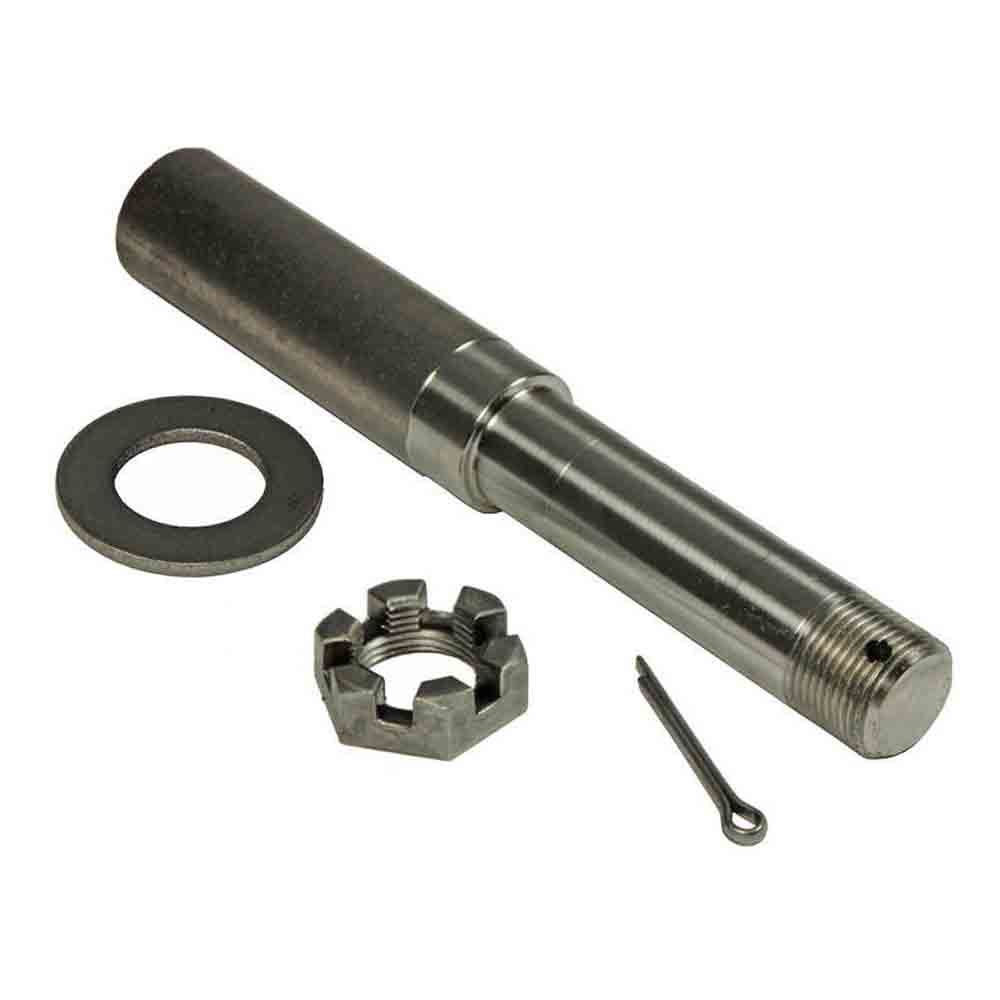
Can changes in the vehicle’s ride height impact the angles and performance of axle spindles?
Yes, changes in the vehicle’s ride height can indeed impact the angles and performance of axle spindles. Here is a detailed explanation:
The ride height of a vehicle refers to the distance between the ground and the chassis or body of the vehicle. It is determined by several factors, including the suspension system, springs, shocks, and overall design. Altering the ride height, either by raising or lowering the vehicle, can have various effects on the angles and performance of the axle spindles.
Here are some ways in which changes in ride height can impact the axle spindles:
- Steering Geometry: The angles and geometry of the steering system are closely linked to the ride height of the vehicle. When the ride height is modified, it can affect the steering angles, such as the caster, camber, and toe. These angles determine how the wheels interact with the road surface and influence the handling, stability, and tire wear. Any alteration to the steering geometry can indirectly impact the axle spindles and their performance.
- Axle Alignment: Changes in ride height can also affect the alignment of the axles. Raising or lowering the vehicle can lead to changes in the relative position and alignment of the front and rear axles. This can introduce changes in the suspension geometry, including the axle angles, which in turn can affect the load distribution, tire contact patch, and overall performance of the axle spindles.
- Components Interference: In some cases, significant changes in ride height can lead to interference issues between suspension components and other parts of the vehicle. For example, lowering the vehicle excessively can cause the axle spindles or other suspension elements to come into contact with the body, frame, or other nearby components. This can result in limited suspension travel, reduced performance, or potential damage to the axle spindles.
- Suspension Travel and Dynamics: Altering the ride height can affect the suspension travel and dynamics of the vehicle. Lowering the ride height typically reduces the suspension’s range of motion, which can impact the ability of the axle spindles to absorb bumps, maintain tire contact with the road, and provide adequate suspension travel. Conversely, raising the ride height can increase the suspension travel but may also affect the vehicle’s center of gravity and stability.
- Ground Clearance: Changes in ride height can impact the vehicle’s ground clearance, which is the distance between the lowest point of the vehicle and the ground. Lowering the ride height reduces ground clearance, potentially increasing the risk of the axle spindles or other undercarriage components scraping or hitting obstacles on the road. This can lead to damage or premature wear of the axle spindles if they come into contact with road hazards.
It’s worth noting that modifying the ride height of a vehicle, particularly beyond the manufacturer’s specifications, can have implications on various aspects of vehicle performance, including the axle spindles. Therefore, it’s important to consider these factors and exercise caution when making ride height adjustments.
If you are considering changing the ride height of your vehicle, it is recommended to consult with knowledgeable professionals or experienced enthusiasts who are familiar with the specific vehicle model and its suspension system. They can provide guidance on appropriate modifications, potential impacts on the axle spindles, and the overall performance and safety of the vehicle.
In summary, changes in a vehicle’s ride height can impact the angles and performance of axle spindles. These changes can affect steering geometry, axle alignment, component interference, suspension travel and dynamics, as well as ground clearance. It’s important to consider these factors and seek expert advice when modifying the ride height to ensure optimal performance and safety of the axle spindles and the vehicle as a whole.

Can a failing axle spindle affect tire wear and alignment?
Yes, a failing axle spindle can indeed affect tire wear and alignment. Here’s a detailed explanation:
When an axle spindle is failing or damaged, it can have a direct impact on tire wear and alignment, leading to various issues. Here are some ways a failing axle spindle can affect tire wear and alignment:
- Uneven Tire Wear: A failing axle spindle can cause uneven tire wear patterns. The misalignment or instability resulting from a damaged spindle can lead to irregular contact between the tire and the road surface. This can cause specific areas of the tire to wear down more quickly than others. Common patterns of uneven tire wear include excessive wear on the edges or center of the tire, scalloping, cupping, or feathering. Uneven tire wear not only compromises tire lifespan but also affects vehicle handling and performance.
- Pulling or Drifting: A failing axle spindle can cause the vehicle to pull or drift to one side. This misalignment can be a result of the damaged spindle not allowing the wheels to be properly aligned. As a consequence, the tires on one side of the vehicle may experience increased friction and wear compared to the other side. This can lead to uneven tire wear and affect the vehicle’s stability and handling.
- Decreased Traction: A failing axle spindle can result in reduced traction between the tires and the road surface. Misalignment or instability caused by a damaged spindle can affect the tire’s ability to maintain optimal contact with the road. This can lead to decreased grip and traction, particularly during cornering or in wet or slippery conditions. Decreased traction not only affects tire wear but also compromises the vehicle’s overall safety and handling.
- Alignment Issues: A failing axle spindle can contribute to alignment problems. The damaged spindle may prevent the proper adjustment and alignment of the wheels. This can result in misaligned toe, camber, or caster angles, which directly impact tire wear. Improper alignment puts uneven stress on the tires, leading to accelerated wear and reduced tire lifespan.
- Compromised Steering Stability: A failing axle spindle can affect steering stability. Instability or misalignment caused by a damaged spindle can result in imprecise steering response and reduced control over the vehicle. This can lead to uneven tire loading and wear, as well as affect the overall handling and safety of the vehicle.
Addressing a failing axle spindle is crucial to prevent further damage to the tires and maintain proper alignment. If you notice uneven tire wear, pulling or drifting, decreased traction, or other signs of tire-related issues, it’s recommended to have the axle spindle inspected by a qualified mechanic or technician. They can accurately diagnose the problem and perform the necessary repairs or replacement to restore proper alignment and prevent further tire wear and damage.
In summary, a failing axle spindle can have a direct impact on tire wear and alignment. It can cause uneven tire wear, pulling or drifting, decreased traction, alignment issues, and compromised steering stability. Timely inspection and repair of the failing axle spindle are essential to ensure optimal tire performance, prolong tire lifespan, and maintain safe vehicle operation.


editor by CX 2024-04-08
China Best Sales 4crnimo6 Large Wind Power Shaft 36CrNiMo4 Wind Power Generator Spindle axle car part
Product Description
Product Description
King Steel can machine and manufacture wind turbine main shafts for customers. We can specialize in the production of wind turbine shafts of different specifications.
We can provide wind turbine main shafts of various materials, such as ZG430640 cast steel, 60#, 65#, 65Mn, 42CrMoA or according to your requirements.
The wind turbine shafts we produce can meet most international standards, such as ASTM, ASME, DIN, JIS, ISO, BS, API, EN.
Specification:
Material: 34CrNiMo6, 42CrMo4
Weight: about 15t
Production capacity: 0.75MW-3MW
Maximum weight: 23T
Craft: Forging and Casting
Usage: used for wind power generation
Inspection: During each process and after the product is finally manufactured, all items are thoroughly inspected and tested to ensure the highest quality products are put on the market.
|
Product |
wind turbine main shaft |
|
Materials |
carbon steel,alloy steel, stainless steel, according to drawing. |
|
Standard |
ASTM, AISI, ASME, DIN, EN, AS, GB. |
|
Processing range |
outer diameter Max1400mm, length Max18000mm. |
|
Main processes |
forging, heat treatment, machining |
|
Main tests |
chemical composition, mechanical properties, PT, UT, MT, hardness, size, roughness. |
|
Major exporting countries |
Australia, the United States, Italy, Germany, Finland, Norway, Thailand, India, etc. |
|
Application |
Wind turbine |
Manufacturing process:
Rraw matrial — Forging testing– Turning — Drilling — Heat Treatment — Milling– Grinding — Shaping and hobbing Process — Packing — Shipping.
After Sales Service
1. OEM and customized service.
2. Full machining, primer coating, surface treatment.
3. Complete material testing process.
4. Quality control
Contact us
Please contact us for more information and quotations.
/* March 10, 2571 17:59:20 */!function(){function s(e,r){var a,o={};try{e&&e.split(“,”).forEach(function(e,t){e&&(a=e.match(/(.*?):(.*)$/))&&1
| Material: | Alloy Steel |
|---|---|
| Load: | Central Spindle |
| Stiffness & Flexibility: | Stiffness / Rigid Axle |
| Customization: |
Available
| Customized Request |
|---|
.shipping-cost-tm .tm-status-off{background: none;padding:0;color: #1470cc}
|
Shipping Cost:
Estimated freight per unit. |
about shipping cost and estimated delivery time. |
|---|
| Payment Method: |
|
|---|---|
|
Initial Payment Full Payment |
| Currency: | US$ |
|---|
| Return&refunds: | You can apply for a refund up to 30 days after receipt of the products. |
|---|
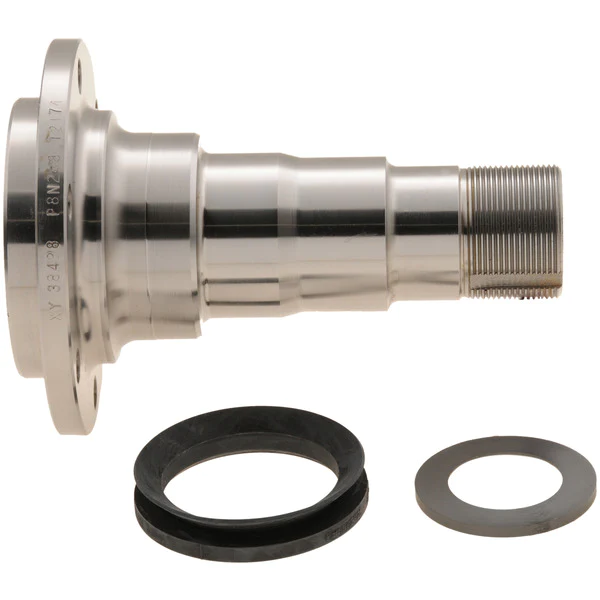
Are there specific tools required for removing and installing an axle spindle assembly?
Yes, removing and installing an axle spindle assembly typically requires specific tools to ensure the task is performed correctly and efficiently. Here’s a detailed explanation of some of the tools commonly used for this job:
- Hydraulic Jack and Jack Stands: These tools are used to safely lift and support the vehicle off the ground, providing access to the axle spindle assembly. A hydraulic jack is used to raise the vehicle, while jack stands are placed under the chassis to secure it at the desired height.
- Socket Set and Wrenches: A socket set with various socket sizes and wrenches is essential for loosening and tightening the fasteners that secure the axle spindle assembly and its associated components. These tools enable you to remove nuts, bolts, and other fasteners during disassembly and reinstall them during assembly.
- Pry Bar or Ball Joint Separator: A pry bar or a ball joint separator may be needed to separate ball joints, tie rod ends, or other connections that are attached to the axle spindle. These tools help to release the components without damaging them or the spindle assembly.
- Torque Wrench: To ensure proper torque specifications are met during assembly, a torque wrench is essential. It allows you to apply the correct amount of torque to the fasteners, ensuring they are neither too loose nor too tight. Over- or under-tightening can lead to component failure or damage.
- Axle Nut Socket: In some cases, a specialized socket known as an axle nut socket is required to remove and install the axle nut that secures the axle shaft to the wheel hub. This socket is designed to fit the specific size and shape of the axle nut, allowing for proper engagement and torque application.
- Bearing Puller or Press: Depending on the design of the wheel bearing assembly, a bearing puller or press may be necessary to remove the old bearing from the axle spindle or to install a new bearing. These tools ensure controlled and precise removal or installation of the bearing, minimizing the risk of damage to the spindle or the new bearing.
- Brake Tools: If the axle spindle is associated with the brake system, you may need specific brake tools such as a caliper piston tool, brake pad spreader, or brake bleeder kit to properly disassemble and reassemble the brake components during the axle spindle replacement.
- Shop Manual or Repair Guide: While not a physical tool, having access to the vehicle’s shop manual or a reliable repair guide is crucial. These resources provide step-by-step instructions, torque specifications, and other essential information specific to your vehicle make, model, and year.
It’s important to note that the specific tools required for removing and installing an axle spindle assembly can vary depending on the vehicle’s make, model, and design. Additionally, certain specialized tools may be needed for specific axle spindle configurations or unique components associated with the assembly.
Before attempting to replace an axle spindle assembly, it’s strongly recommended to consult the vehicle’s shop manual or a trusted repair guide to identify the specific tools required and to understand the proper procedures for your particular vehicle. If you lack the necessary tools or experience, it is advisable to seek assistance from a professional mechanic or technician who has the expertise and appropriate tools for the job.
In summary, specific tools are typically required for removing and installing an axle spindle assembly. These tools include a hydraulic jack, jack stands, socket set, wrenches, pry bar, torque wrench, axle nut socket, bearing puller or press, brake tools (if applicable), and access to a shop manual or repair guide. Utilizing the correct tools ensures that the job is performed safely and accurately.
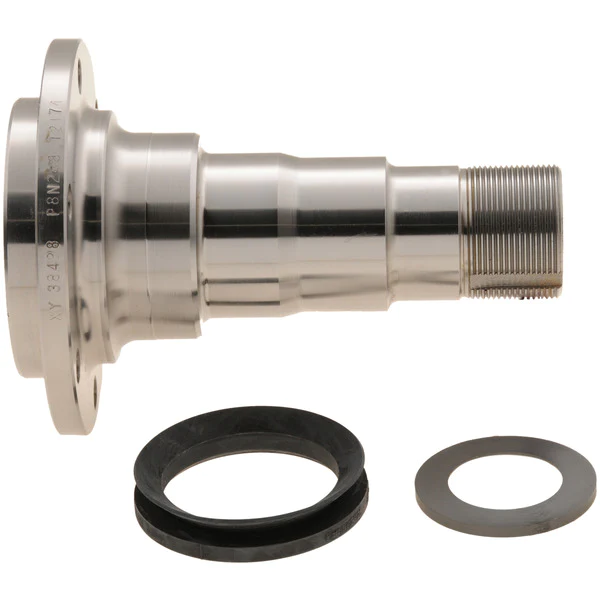
How often should axle spindles be inspected as part of routine vehicle maintenance?
Inspecting axle spindles as part of routine vehicle maintenance is crucial for ensuring their continued performance, safety, and longevity. The frequency of axle spindle inspections can vary depending on several factors, including the vehicle type, driving conditions, and manufacturer recommendations. Here are some general guidelines:
- Manufacturer Recommendations: Refer to the vehicle’s owner’s manual or the manufacturer’s maintenance schedule for specific guidelines on axle spindle inspections. Manufacturers often provide recommended inspection intervals based on mileage or time, such as every 30,000 miles or every 2 years. Following the manufacturer’s recommendations ensures that you adhere to their specified maintenance intervals.
- Driving Conditions: Consider the driving conditions in which your vehicle operates. If you frequently drive in severe conditions such as off-road, dusty, or high-temperature environments, the axle spindles may require more frequent inspections. These conditions can contribute to accelerated wear or potential damage to the spindles, making more frequent inspections necessary to detect any issues early on.
- Visual Inspections: Perform visual inspections of the axle spindles regularly, especially during routine tire maintenance or brake inspections. Look for signs of damage, such as cracks, corrosion, or bent spindles. Pay attention to any unusual noise, vibration, or steering irregularities, as they can indicate potential issues with the spindles. If any abnormalities are observed, a more thorough inspection or professional evaluation should be conducted.
- Service Intervals: Take advantage of regular service intervals, such as oil changes or tire rotations, to have a qualified mechanic inspect the axle spindles. They can assess the condition of the spindles, check for proper lubrication, and identify any signs of wear or damage. The mechanic can recommend specific inspection intervals based on their expertise and the vehicle’s condition.
- Preventive Maintenance: In addition to regular inspections, consider incorporating preventive maintenance practices for your vehicle. This can include proactive measures such as applying protective coatings to the spindles, ensuring proper wheel alignment, and maintaining appropriate tire pressures. These actions can contribute to the longevity and optimal performance of the axle spindles.
It is important to note that the guidelines provided are general recommendations, and specific vehicle models or manufacturers may have different requirements. Therefore, always consult the vehicle’s owner’s manual or seek advice from a qualified mechanic or authorized dealership to determine the appropriate inspection frequency for the axle spindles in your vehicle.
Regular inspections of the axle spindles as part of routine vehicle maintenance help identify potential issues early, prevent further damage, and maintain the overall safety and reliability of the vehicle.
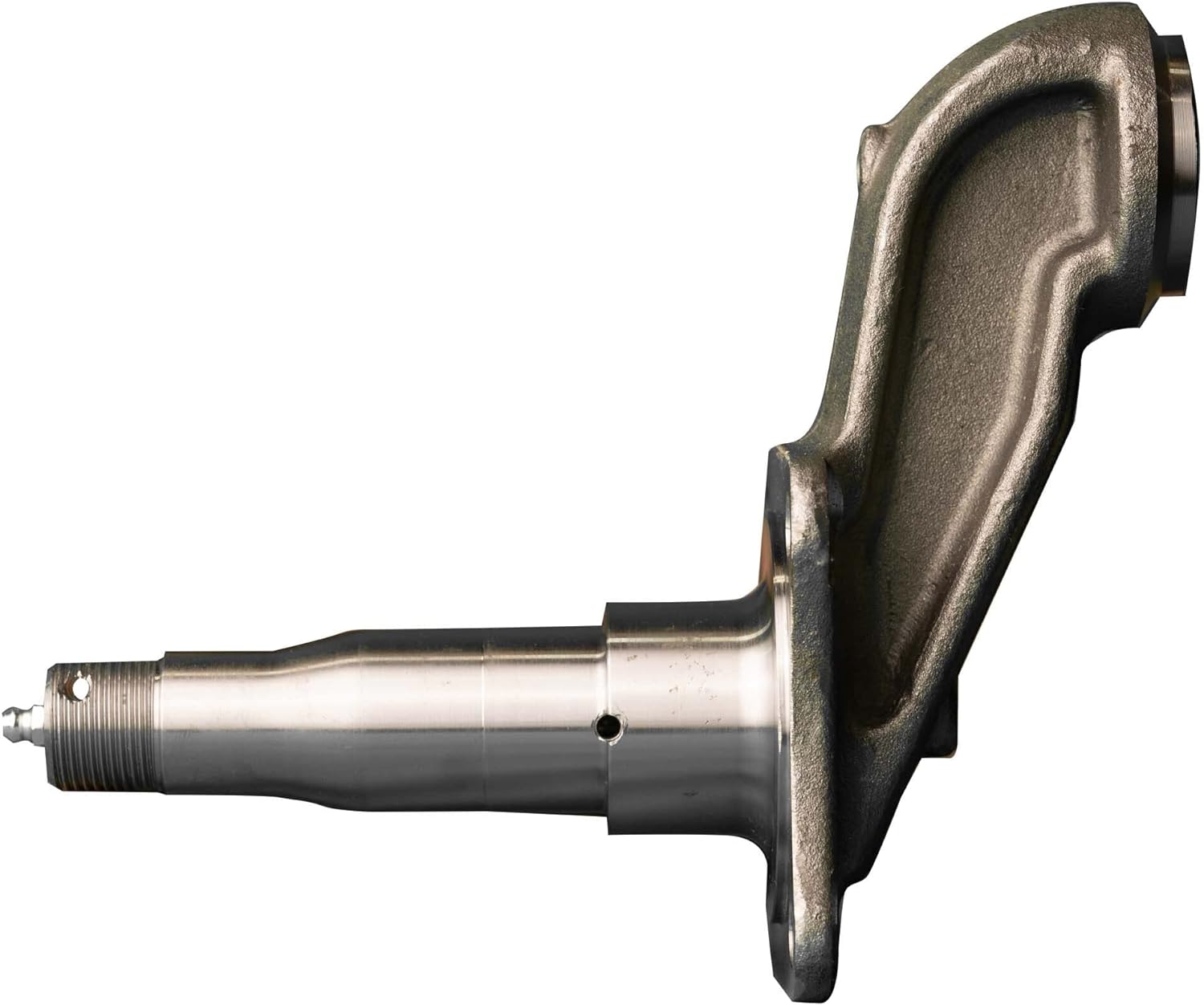
What is the primary role of the axle spindle in a vehicle’s suspension system?
The primary role of the axle spindle in a vehicle’s suspension system is to support and facilitate the rotation of the wheel assembly. Here’s a detailed explanation:
The axle spindle, also known as the wheel spindle or stub axle, is a component of the suspension system that connects the wheel hub assembly to the suspension system. It plays a crucial role in supporting the weight of the vehicle, transmitting driving forces, and allowing the wheel assembly to rotate smoothly.
Here are the primary functions and roles of the axle spindle:
- Wheel Mounting: The axle spindle provides a mounting point for the wheel hub assembly. It typically extends from the steering knuckle or axle beam and incorporates a flange or hub surface where the wheel is mounted. The spindle ensures proper alignment and secure attachment of the wheel to the suspension system.
- Load Support: One of the main responsibilities of the axle spindle is to support the weight of the vehicle and any additional loads. It transfers the vertical load from the wheel assembly to the suspension system and ultimately to the vehicle chassis. The spindle should be designed to withstand the weight and forces encountered during normal driving conditions.
- Wheel Rotation: The axle spindle allows the wheel assembly to rotate freely. It acts as an axle or pivot point around which the wheel rotates when the vehicle is in motion. The spindle is typically designed with a smooth, cylindrical shape that fits into the wheel bearings, allowing for low-friction rotation.
- Steering Function: In some suspension systems, particularly those with steering knuckles, the axle spindle also plays a role in the steering function. It connects to the steering linkage or tie rods, allowing for the controlled movement of the wheel assembly during steering maneuvers. The spindle’s design and attachment points should facilitate the proper functioning of the steering system.
- Transmission of Forces: The axle spindle transmits driving and braking forces from the wheel assembly to the suspension system. These forces include torque from the engine during acceleration and braking forces when the brakes are applied. The spindle should be able to handle these forces without failure or excessive deflection.
It’s important to note that the design and construction of axle spindles can vary depending on the specific suspension system used in a vehicle. Different suspension types, such as independent suspension or solid axle suspension, may have variations in spindle design and attachment methods. Additionally, the axle spindle must be properly lubricated and maintained to ensure smooth operation and longevity.
In summary, the primary role of the axle spindle in a vehicle’s suspension system is to support and facilitate the rotation of the wheel assembly. It provides a mounting point for the wheel hub assembly, supports the vehicle’s weight, allows for wheel rotation, contributes to the steering function, and transmits driving forces. The design and construction of the axle spindle may vary depending on the suspension system used in the vehicle.


editor by CX 2024-02-06